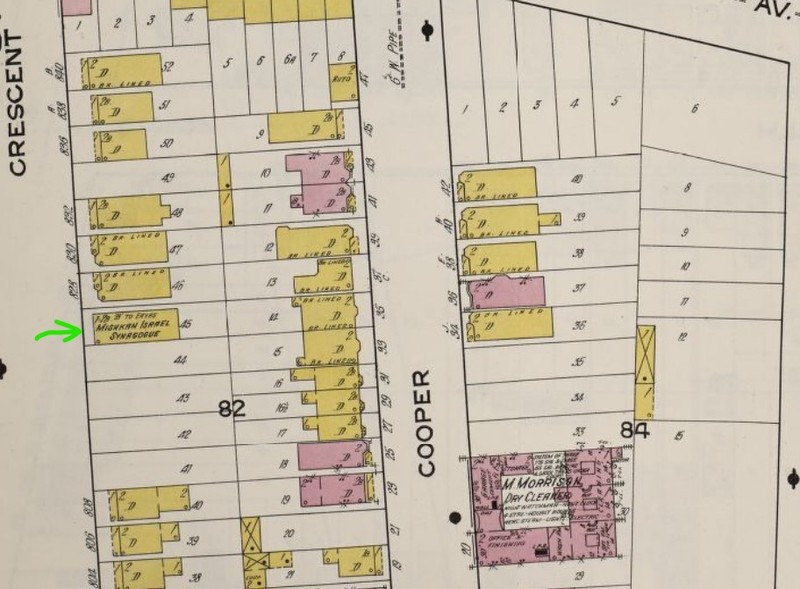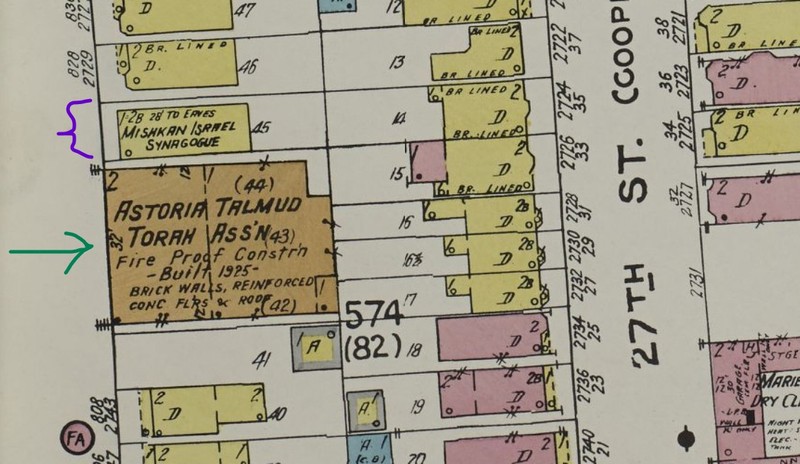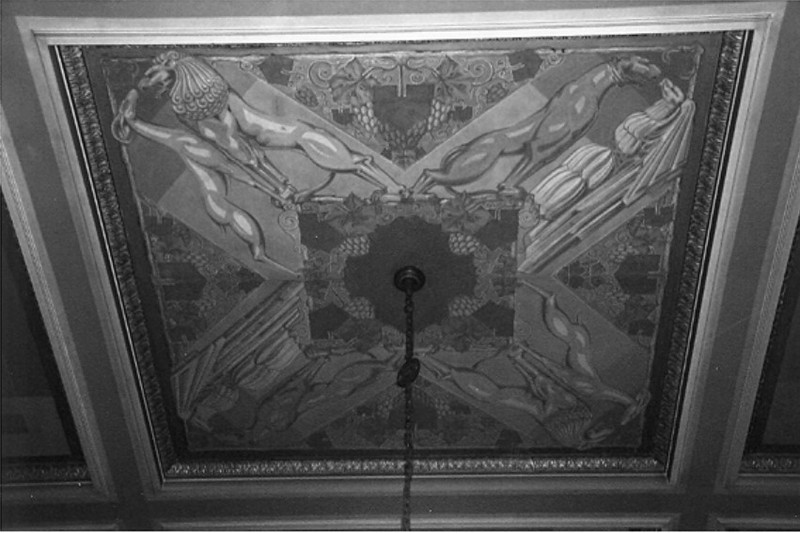Astoria Center of Israel
Introduction
Text-to-speech Audio
The red brick building with stone accents at 27-35 Crescent St. is the Astoria Center of Israel, one of the oldest synagogues in Queens. It was built in 1925 to 1926 as a religious education and community center, next to the Jewish congregation of Mishkan Israel's 1906 synagogue. Although the Mishkan Israel Synagogue stood next door until it was destroyed in a fire in the 1980s, some religious services were held in the Astoria Center since its early years. The interior has murals painted by French artist Louis Rigal around 1929. The Astoria Center of Israel has been listed on the National Register of Historic Places since 2009 and still houses an active, egalitarian conservative Jewish synagogue.
Images
Main facade of Astoria Center of Israel in 2009 photo for NRHP nomination (Anthony W. Robins)

Mural wall in main sanctuary of Astoria Center in 2009 photo (Anthony W. Robins)

Former Synagogue building (green arrow) next to future site of Astoria Center on 1915 map (Sanborn V. 2 p. 16)

"Astoria Talmud Torah Assn." (green arrow) next to former Mishkan Israel Synagogue (purple bracket; Sanborn V. 2 p. 16)

Mural on central panel of main sanctuary ceiling of Astoria Center of Israel in 2009 photo (Robins)

View toward balcony in main sanctuary of Astoria Center of Israel in 2009 photo (Robins)

Backstory and Context
Text-to-speech Audio
At the urging of The Ladies Aid Society, it was decided in 1921 to build a Jewish education center (Talmud Torah) next door to the Mishkan Israel Synagogue (which was built in 1906). The Astoria Torah Talmud Association was formed in January 1925. By that time, the plans had been expanded to include more functions for the new building, including meeting space and places for High Holy Days services. Architect Louis Allen Abramson (1887-1985) designed the Astoria Center of Israel building in 1925. The building's cornerstone was laid in November 1925 and the building was dedicated in March 1926.The building became a center of Jewish life for the growing local population. The Center's first president was Isaac Baer, an immigrant from Romania and a successful builder. The congregation's young rabbi in 1926 was Joshua Goldberg, who emigrated from his native Belarus during World War I. He had been trained in a Reform seminary, and eventually, religious services in the Astoria Center were separate from those of its Orthodox Jewish next-door neighbor.
The center is known for its murals in the main sanctuary painted by Louis Pierre Rigal (1889-1985) around 1929. The murals represent the four ideals of Jewish behavior from the saying "Be bold as a leopard, light as an eagle, swift as a gazelle, and strong as a lion." Rigal painted the four animals in gold on the tall walls on the front walls on either side of the pulpit. Above the pulpit, he painted a white dove holding an olive branch in its mouth. The main sanctuary's ceilings are divided into fifteen square panels containing more of Rigal's paintings; some are repeated geometric designs and others included pairs of the four animals and olive branches. The murals have faded somewhat and were discolored slightly from smoke when the neighboring Mishkan Israel Synagogue burned down in the 1980s but are still impressive. Rigal went on to paint classical murals in the main foyer of the Waldorf-Astoria Hotel in Manhattan in 1931. A master metal craftsman and German immigrant, Oscar B. Bach (1884-1957) of New York, designed chandeliers for the Astoria Center. A chandelier in the center of the main sanctuary carries one of Bach's signature features, adding color to metal.
There are classrooms on the second floor of the Astoria Center, a rear balcony in the main sanctuary, and a social hall that has been modernized in the basement. Rabbi Jonathan Pearl had been at the synagogue/ Jewish center for a year by the time the building was honored by being added to the New York and National Registers. The previous rabbi, Alvin Kass, emphasized that no matter how beautiful the building was, it was the people who made the place special. The congregation numbered about 100 in 2009.
The building's cast stone trim is designed to look like limestone, and form six two-story flat Ionic piers across the front in a modified temple design. The main entrance is in the central of five bays, with round-arched windows in the neighboring bays with leaded-glass windows in a multicolored geometric design. The frieze is inscribed with the building's name. In 2009, the front of the building was still topped by a baluster (as in the photo below); this appears to have been removed. There is a south cornerstone engraved with 1925, 5686, and the building's name.
Sources
Astoria Center of Israel. Our History, About Us. January 1st 2022. Accessed May 9th 2022. http://www.astoriacenter.org/about-us/our-history.
JewishGen. Astoria Center of Israel, QUEENS in NY, US, Online Worldwide Burial Registry: Memorial, USA-00171. Accessed May 12th 2022. http://data.jewishgen.org/IMAGEDATA/Memorial/USA-00171/aci.html.
Robins, Anthony W. Bartos, Virginia. NRHP Nomination of Astoria Center of Israel, Queens, N.Y. National Register. Washington, DC. National Park Service, 2009.
Walsh, Jeremy. "Synagogue in Astoria Landmarked." Astoria Times (New York) November 19th 2009. , 1-1.
New York State Cultural Resource Information System (NYS CRIS): https://cris.parks.ny.gov/Default.aspx
NRHP nomination: https://anthonywrobins.com/National%20Register%20nominations/Astoria%20Center%20of%20Israel%20-%20NR.pdf
Library of Congress (LOC): https://www.loc.gov/item/sanborn06198_007/
LOC: https://www.loc.gov/item/sanborn06198_019/
NRHP nomination: https://anthonywrobins.com/National%20Register%20nominations/Astoria%20Center%20of%20Israel%20-%20NR.pdf
NRHP nomination: https://anthonywrobins.com/National%20Register%20nominations/Astoria%20Center%20of%20Israel%20-%20NR.pdf
